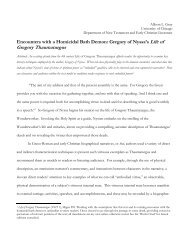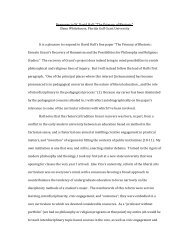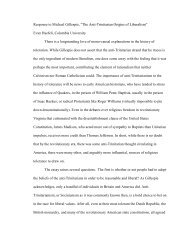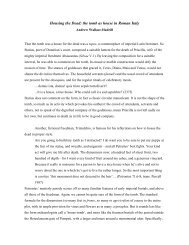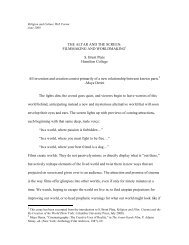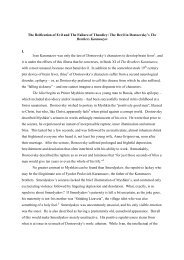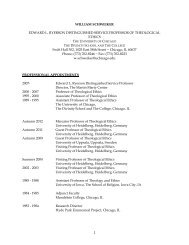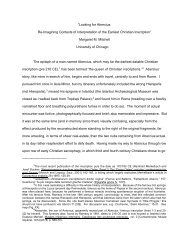*Criterion Winter 02-4.16 - Divinity School - University of Chicago
*Criterion Winter 02-4.16 - Divinity School - University of Chicago
*Criterion Winter 02-4.16 - Divinity School - University of Chicago
You also want an ePaper? Increase the reach of your titles
YUMPU automatically turns print PDFs into web optimized ePapers that Google loves.
Wilde lived and loomed so large on the public scene as to become<br />
a caricature <strong>of</strong> himself, and quite early in his career.<br />
the distinctive traits <strong>of</strong> his sexuality. Even given youth and<br />
university culture, contexts tolerant and even indulgent<br />
<strong>of</strong> eccentricity, Wilde was excessive. His behaviors and affectations<br />
seem a defense calculated to secure his advantage.<br />
His exotic tastes in dress, his exaggerated gestures and theatrical<br />
poses incarnate the maxim that the best defense is a<br />
good <strong>of</strong>fense. His considerable height and substantial frame<br />
made him a flaming queen <strong>of</strong> magnificent proportion, and<br />
afforded advantage in the more usual arts <strong>of</strong> manly selfdefense.<br />
Joseph Pearce records:<br />
In his memoirs, Sir Frank Benson recalls . . . Wilde’s<br />
response to a group <strong>of</strong> students who arrived at his<br />
rooms intent on giving him a beating. Four undergraduates<br />
were deputed to burst into Wilde’s rooms<br />
while the rest watched from the stairs. The assailants<br />
received more than they expected. According to Benson,<br />
Wilde booted out the first, doubled up the second<br />
with a punch, threw out the third through the air, and<br />
taking hold <strong>of</strong> the fourth—a man as big as himself—<br />
carried him down to his rooms and buried him<br />
beneath his own furniture. As a final coup de théatre<br />
Wilde helped himself to his assailant’s wines and spirits<br />
and invited the astounded spectators to join him. 3<br />
Such exploits—coupled to his undeniable intelligence,<br />
his gifts for repartee, and a reputation for gentle, generous<br />
kindness that adhered to him throughout his tumultuous<br />
life—made Wilde a remarkable figure. As one biographer<br />
notes, “He read Herbert Spencer and the philosopher <strong>of</strong><br />
science William Kingdon Clifford; he was on easy terms<br />
not only with Plato and Aristotle, as required by his course,<br />
but with Kant, Hegel, Jacobi, Locke, Hume, Berkeley, and<br />
Mill. He alludes knowledgeably to Alfieri and quotes<br />
Baudelaire.” 4 A combination <strong>of</strong> best-little-boy and wicked<br />
show-<strong>of</strong>f, Wilde attracted attention, and a following. Hated<br />
or beloved, he was the kind <strong>of</strong> person who elicited strong<br />
opinion, and that was as he would have it, for Wilde was an<br />
early exponent <strong>of</strong> self-franchise.<br />
Wilde lived and loomed so large on the public scene as to<br />
become a caricature <strong>of</strong> himself, and quite early in his career.<br />
12 WINTER 20<strong>02</strong><br />
While still a student he amassed a formidable balance <strong>of</strong><br />
celebrity capital against which he learned to draw with skill.<br />
Loosed upon London, he set about in earnest to make his<br />
reputation. “He had . . . a large acquaintance, in which royalty<br />
was not lacking. The Prince <strong>of</strong> Wales asked to meet him,<br />
fetching up an epigram for the purpose, ‘I do not know Mr<br />
Wilde, and not to know Mr Wilde is not to be known!’” 5<br />
Wilde stood at the vanguard <strong>of</strong> a group <strong>of</strong> artists known as<br />
the Aesthetic Movement. These artists were caricatured by<br />
Gilbert and Sullivan in their operetta Patience. When the<br />
prominent theatrical producers, the D’Oyly Carte, sought to<br />
export Patience to American audiences, their American<br />
representative wondered “‘how the New York public could<br />
be brought to understand the aesthetic craze’ and so better<br />
appreciate the subtle humour <strong>of</strong> Patience.” 6 The solution was<br />
to book Wilde on a promotional lecture tour. Decked out in<br />
velvet jacket and knee britches, silk hose, and outlandishly<br />
foppish hat, this towering man with flowing tresses and a<br />
lily in his hand lectured on stage from coast to coast. Whatever<br />
the benefit to D’Oyly Carte and their theatrical production,<br />
Wilde managed to turn the tour to his own personal advantage,<br />
cultivating his identity as a brand, a nineteenth-century<br />
precursor <strong>of</strong> Martha Stewart:<br />
[Wilde toured numerous cities delivering a lecture<br />
on] ‘The English Renaissance’ until his arrival in<br />
<strong>Chicago</strong> in February. There he had eventually to<br />
speak twice, and when he learned from the report in<br />
the Buffalo Courier that the <strong>Chicago</strong> papers already<br />
had ‘The English Renaissance’ in type, he hastily put<br />
together two new lectures, which he gave from that<br />
time on. One, delivered on his second visit, in March,<br />
became known as ‘The House Beautiful’ . . . The<br />
other, first given on 13 February, was ‘The Decorative<br />
Arts.’ Both these lectures differed from the first, since<br />
instead <strong>of</strong> being historical, they <strong>of</strong>fered practical<br />
applications <strong>of</strong> aesthetic doctrine. [Hence the comparison<br />
to Martha Stewart.]<br />
. . . He moved fluently from point to point, not worrying<br />
much about organization, trusting to what quickly




